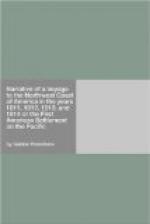The men are generally well made and tall: they wear for their entire clothing what they call a maro; it is a piece of figured or white tapa, two yards long and a foot wide, which they pass round the loins and between the legs, tying the ends in a knot over the left hip. At first sight I thought they were painted red, but soon perceived that it was the natural color of their skin. The women wear a petticoat of the same stuff as the maro, but wider and longer, without, however, reaching below the knees. They have sufficiently regular features, and but for the color, may pass, generally speaking, for handsome women. Some to heighten their charms, dye their black hair (cut short for the purpose) with quick lime, forming round the head a strip of pure white, which disfigures them monstrously. Others among the young wear a more becoming garland of flowers. For other traits, they are very lascivious, and far from observing a modest reserve, especially toward strangers. In regard to articles of mere ornament, I was told that they were not the same in all the island. I did not see them, either, clothed in their war dresses, or habits of ceremony. But I had an opportunity to see them paint or print their tapa, or bark cloth, an occupation in which they employ a great deal of care and patience. The pigments they use are derived from vegetable juices, prepared with the oil of the cocoa-nut. Their pencils are little reeds or canes of bamboo, at the extremity of which they carve out divers sorts of flowers. First they tinge the cloth they mean to print, yellow, green, or some other color which forms the ground: then they draw upon it perfectly straight lines, without any other guide but the eye; lastly they dip the ends of the bamboo sticks in paint of a different tint from the ground, and apply them between the dark or bright bars thus formed. This cloth resembles a good deal our calicoes and printed cottons; the oils with which it is impregnated renders it impervious to water. It is said that the natives of Atowy excel all the other islanders in the art of painting the tapa.
The Sandwich-islanders live in villages of one or two hundred houses arranged without symmetry, or rather grouped together in complete defiance of it. These houses are constructed (as I have before said) of posts driven in the ground, covered with long dry grass, and walled with matting; the thatched roof gives them a sort of resemblance to our Canadian barns or granges. The length of each house varies according to the number of the family which occupies it: they are not smoky like the wigwams of our Indians, the fireplace being always outside in the open air, where all the cooking is performed. Hence their dwellings are very clean and neat inside.




